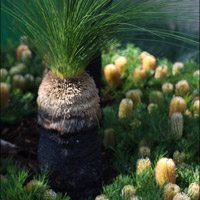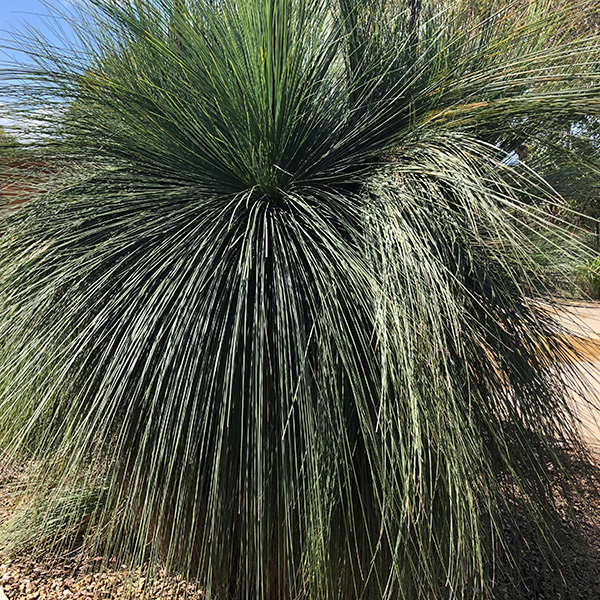Southern or Austral Grass Tree

The species Xanthorrhoea australis is commonly called the The Austral Grass Tree, Common or Southern Grass Tree. And it is probably the most widely found of all of the grass trees.
With the common nickname of Black Boy plant, this is derived from the black trunks, usually as a result of fires, sometimes lit to clear land and other time bushfires.
Also known as Balga grass, it is found as an under story plant in Victoria, New South Wales and Tasmania. Very popular as a landscaping plant Xanthorrhoea australis has a number of desirable features for this application.

Frost tolerant, able to cope with poor soils, grows well in full sun to part shade and requiring little fertilizer and water once established.
These are an evergreen plant, slow growing at around 2cm a year depending on conditions.
The slow growing nature means that mature specimens tend to come at a high cost as with other grass tree species.
Xanthorrhoea australis Uses
- In many landscaping situations Xanthorrhoea australis is planted as a specimen in a planter.
- Larger plants make great specimens in range of landscaping situations.
- Relatively young plants used as low growing features.
Traditional uses include
- Resin obtained from the plant was use both as an adhesive and to make lacquers.
- The flower spike used to make spears.
- The soft white part of the leaf near the base was used eaten.
Height, Cost and Growth Rate
How fast do Xanthorrhoea grow?
In terms of trunk development growth rate is very slow, 3-5cm a year in good conditions.
How High do they get?
Generally trunks or stems will reach up to 3 metres in height, however this is over many years. T
Why are they so expensive?
The slow growth rate makes mature specimens very expensive to buy. Taller specimens are available at a cost, a 3m specimen might take 100 years or so to reach that height.
Problems and Care
- A well drained position is essential, Xanthorrhoea australis does not cope with water logged soils.
- Use of fertilizers with high levels of phosphate is a problem, these plants do best in a native garden where the level of phosphorous is not raised.
- Disease seems to be mainly limited to root rot (Phytophthora cinnamomi). Anthracnose one another disease that is a possibility.
- When purchasing larger specimens look for plants with a large root ball, usually balled and burlaped, larger plants that have had roots trimmed to fit into a pot for display in a nursery often do not survive the transplant.
Propagation
Seed pods can be collected when ripe and should be allowed to dry, seeds are then removed from the pod and can be germinated in a free draining potting soil, a little course sand over the top of the seeds will keep them in contact with the potting mix. Keep moist, but do not over water.
All grass trees or Xanthorrhoea species are a slow growing plant and are usually very hardy and long lived. All Grass Trees require a well drained position and a sunny aspect. The tall woody flower spikes are a spectacular feature. Grass Trees may be grown in pots or planters.
Transplanting Problems
Xanthorrhoea australis is a protected species and harvesting is strictly regulated. Without a proper understanding of transplanting techniques most plants harvested from the wild will survive for only around three years.
The root system of these plants is shallow but intense and often far to much of the original root system is removed or damaged.
If you are looking to buy Xanthorrhoea australis, look for plants from licensed and experienced growers
With a wide distribution, they are found in coastal heaths, wet and dry forests in many areas of Australia. Some species such as Xanthorrhoea australis or the ‘Austral Grass Tree’ and others will grow trunks, however other species such as Xanthorrhroea minor or ‘Small Grass Tree’ do not actually grow a trunks at all and are found in the southern parts of Victoria and South Australia.
Other Xanthorrhoea species include :
- Xanthorrhoea preissii. The Balga grasstree
- Xanthorrhoea johnsonii. The Northern Grasstree
- Xanthorrhoea gracilis The slender grass tree
- Xanthorrhoea glauca. From QLD
- Xanthorrhoea quadrangulata. The Square Leaved Grass Tree
- Xanthorrhoea media. A smaller growing species with slender trunk
- Xanthorrhoea semiplana. The tufted grass tree
- Xanthorrhoea thorntonii The ‘Cundeelee Blackboy’ .
- Xanthorrhroea minor The small grass tree (no trunk)
Grass Trees for sale (retail)
1052 Whittlesea-Kinglake Road Kinglake West 3757
Offering a specialist variety of Australian native Ferns plus Dendrobium/Dockrillia & Sarcochilus species & hybrids in pots, loose, or mounted. Species Cymbidium sauve and maddidum.
www.ferns.com.au

